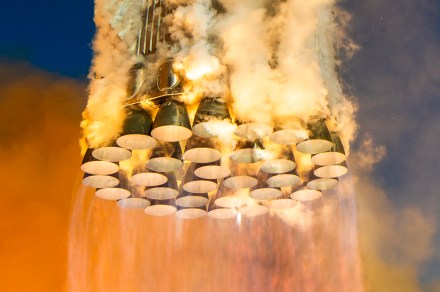By
Trevor Mogg

The Super Heavy booster’s Raptor engines powering the Starship’s launch on November 19, 2024.
SpaceX
SpaceX has posted some incredible images showing the Super Heavy booster’s 33 Raptor engines as they powered the Starship rocket skyward at the start of the vehicle’s sixth test flight on Tuesday.
“[Thirty-three] Raptor engines powering the Super Heavy booster off the pad from Starbase,” SpaceX wrote in the message on X.
SpaceX boss Elon Musk also shared the pictures on his own X account on Wednesday, adding: “Each rocket engine produces twice as much thrust as all 4 engines on a Boeing 747 and there are 33 of them.”
Each rocket engine produces twice as much thrust as all 4 engines on a Boeing 747 and there are 33 of them https://t.co/3D8pEVIvoL
— Elon Musk (@elonmusk) November 21, 2024
The 33 Raptor engines are attached to the Starship’s first-stage Super Heavy booster and produce 17 million pounds of thrust at launch, making it the most powerful rocket ever to fly.
The generated power is almost twice that of the 8.8 million pounds of thrust created by NASA’s new Space Launch System (SLS) rocket, which flew for the first time in 2022. It’s also more than double that of the Saturn V, which generated 7.6 million pounds of thrust during the launches that sent the Apollo astronauts on their way to the moon more than 50 years ago.
But SpaceX’s work doesn’t stop there, as there are plans to increase the power of the Raptor engines to an extent that will see the Super Heavy booster create an astonishing 23 million pounds of thrust during liftoff.
The extra power will significantly enhance the Starship’s ability to carry heavier payloads on its future missions to the moon and possibly even Mars. It would also result in a marked improvement in the rocket’s overall launch efficiency as the increased thrust will reduce gravity losses during the rocket’s ascent, as more of the rocket’s power would be used for acceleration rather than fighting gravity.
Tantalizingly, the extra power could also pave the way for Starship variants even larger than the current 120-meter-tall vehicle that’s currently undergoing testing.
In a nutshell, the improvements to the Starship’s Raptor engines have the potential to help SpaceX reach its goals of reducing launch costs, increasing payload capacity, and enhancing the overall performance of its launch system.
![]()
Not so many moons ago, Trevor moved from one tea-loving island nation that drives on the left (Britain) to another (Japan)…
What to expect from SpaceX’s sixth megarocket test flight

As it unleashes a record 17 million pounds of thrust at launch, the sight of SpaceX’s 120-meter-tall Starship rocket roaring skyward is something to behold.
The Elon Musk-led spaceflight company has already performed five Starship flights since the first one in April 2023, with each one more successful than the last. Comprising the upper-stage Starship spacecraft and the first-stage Super Heavy booster (collectively known as the Starship), the giant vehicle willo be used by NASA for crew and cargo missions to the moon, Mars, and possibly beyond.
SpaceX reveals date for next flight of Starship megarocket

SpaceX has revealed that it is targeting Monday, November 18, for the sixth test of the Starship, the world’s most powerful rocket comprising the first-stage Super Heavy booster and the upper-stage Starship spacecraft.
The massive vehicle, which creates around 17 million pounds of thrust at launch, is set to be used by NASA for crew and cargo missions to the moon, and possibly even Mars, though there’s still much testing to be done.
A SpaceX Crew Dragon is doing a shuffle at the ISS — here’s how to watch

This week will see a special maneuver at the International Space Station (ISS) as a SpaceX Crew Dragon takes one of the tiniest flights ever, hopping just a few meters over from one port of the station to another. And NASA will live stream the event, so you’ll be able to watch the spacecraft take this short flight as it happens.
The changeover is necessary to make space for another SpaceX craft that will arrive on Monday, October 4. But this new arrival won’t carry any crew as it is a cargo craft, part of the 31st commercial resupply services mission by SpaceX. This new arrival will dock at the forward-facing port on the Space Station’s Harmony module, as it is easiest for craft to dock there than on the space-facing side. But the Crew Dragon is currently occupying this port, so it needs to undock, move to the other space-facing port, and redock there.

